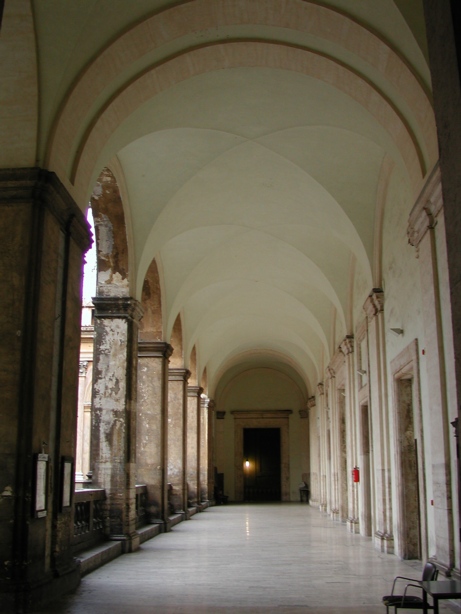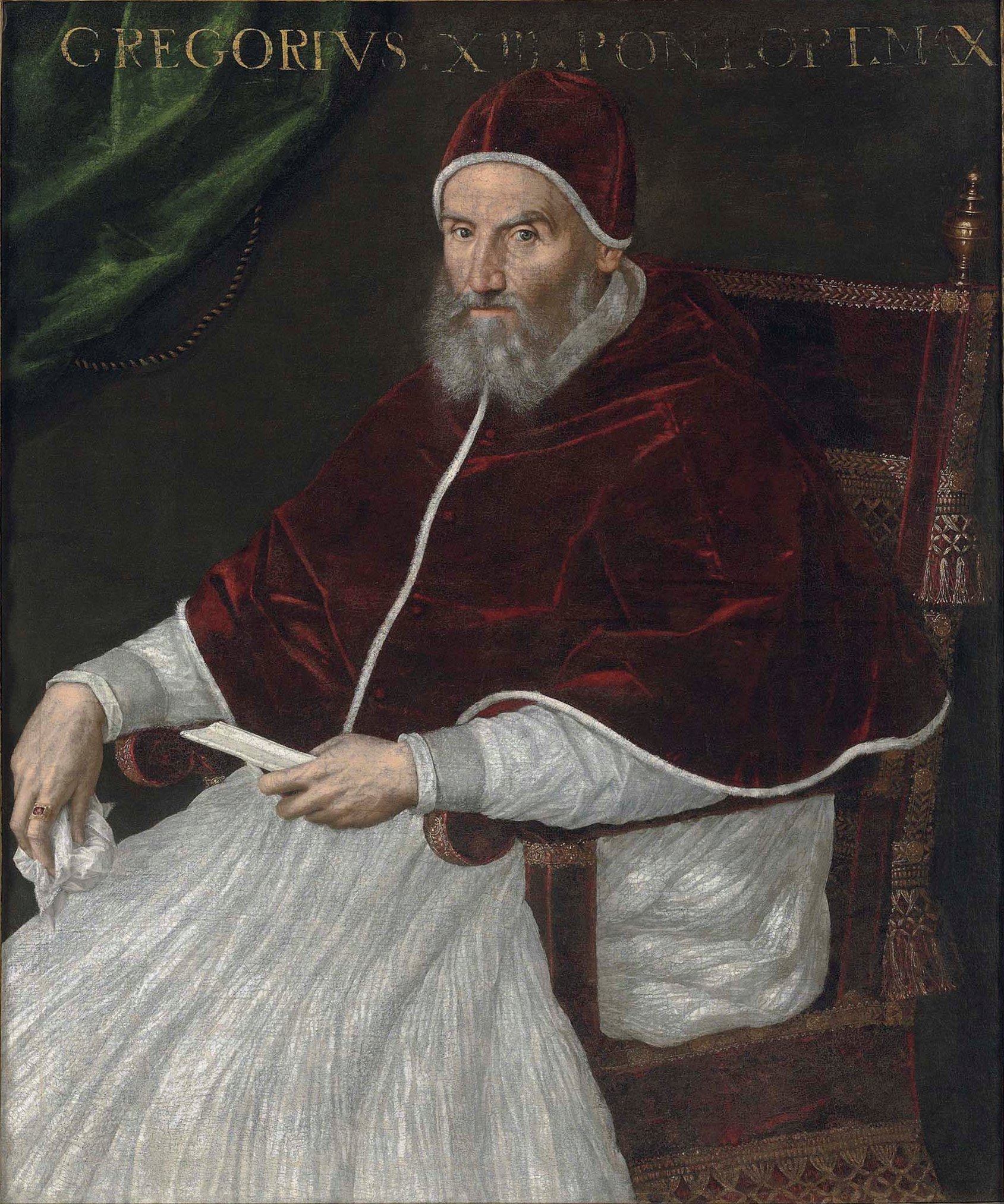|
Roman College
The Roman College (, ) was a school established by St. Ignatius of Loyola in 1551, just 11 years after he founded the Society of Jesus (Jesuits). It quickly grew to include classes from elementary school through university level and moved to several successive locations to accommodate its burgeoning student population. With the patronage of Pope Gregory XIII, the final seat of the Roman College was built in 1584 near the center of Rome's most historic Pigna district, on what today is called Piazza del Collegio Romano, adding the church of St. Ignatius in 1626, and a renowned observatory in 1787. The college remained at this location for 286 years until the revolutionary Capture of Rome in 1870.In 1870, the new Italian government confiscated the property of the university and their building (that eventually became the Ennio Quirino Visconti Liceo Ginnasio), which forced the university to transfer to the Palazzo Gabrielli-Borromeo on the Via del Seminario. In 1873, the remainin ... [...More Info...] [...Related Items...] OR: [Wikipedia] [Google] [Baidu] [Amazon] |
Rome
Rome (Italian language, Italian and , ) is the capital city and most populated (municipality) of Italy. It is also the administrative centre of the Lazio Regions of Italy, region and of the Metropolitan City of Rome. A special named with 2,746,984 residents in , Rome is the list of cities in the European Union by population within city limits, third most populous city in the European Union by population within city limits. The Metropolitan City of Rome Capital, with a population of 4,223,885 residents, is the most populous metropolitan cities of Italy, metropolitan city in Italy. Rome metropolitan area, Its metropolitan area is the third-most populous within Italy. Rome is located in the central-western portion of the Italian Peninsula, within Lazio (Latium), along the shores of the Tiber Valley. Vatican City (the smallest country in the world and headquarters of the worldwide Catholic Church under the governance of the Holy See) is an independent country inside the city boun ... [...More Info...] [...Related Items...] OR: [Wikipedia] [Google] [Baidu] [Amazon] |
Counter-Reformation
The Counter-Reformation (), also sometimes called the Catholic Revival, was the period of Catholic resurgence that was initiated in response to, and as an alternative to or from similar insights as, the Protestant Reformations at the time. It was a comprehensive effort arising from the decrees of the Council of Trent. As a political-historical period, it is frequently dated to have begun with the Council of Trent (1545–1563) and to have ended with the political conclusion of the European wars of religion in 1648, though this is controversial. However, as a theological-historical description, the term may be obsolescent or over-specific: the broader term Catholic Reformation () also encompasses the reforms and movements within the Church in the periods immediately before Protestantism or Trent, and lasting later. The effort produced Apologetics, apologetic and polemical documents, anti-corruption efforts, spiritual movements, the promotion of new religious orders, and the flo ... [...More Info...] [...Related Items...] OR: [Wikipedia] [Google] [Baidu] [Amazon] |
Pope Gregory XIII
Pope Gregory XIII (, , born Ugo Boncompagni; 7 January 1502 – 10 April 1585) was head of the Catholic Church and ruler of the Papal States from 13 May 1572 to his death in April 1585. He is best known for commissioning and being the namesake for the Gregorian calendar, which remains the internationally accepted civil calendar to this day. Early biography Youth Ugo Boncompagni was born the son of Cristoforo Boncompagni (10 July 1470 – 1546) and Angela Marescalchi, and paternal grandson of Giacomo Boncompagni and Camilla Piattesi, in Bologna, where he studied law and graduated in 1530. He later taught jurisprudence for some years, and his students included notable figures such as Cardinals Alexander Farnese, Reginald Pole and Charles Borromeo. He had an illegitimate son after an affair with Maddalena Fulchini, Giacomo Boncompagni, but before he took holy orders, making him the last Pope to have left issue. Career before papacy At the age of 36 he was summoned to Rome ... [...More Info...] [...Related Items...] OR: [Wikipedia] [Google] [Baidu] [Amazon] |
Council Of Trent
The Council of Trent (), held between 1545 and 1563 in Trent (or Trento), now in northern Italy, was the 19th ecumenical council of the Catholic Church. Prompted by the Protestant Reformation at the time, it has been described as the "most impressive embodiment of the ideals of the Counter-Reformation.""Trent, Council of" in Cross, F. L. (ed.) ''The Oxford Dictionary of the Christian Church'', Oxford University Press, 2005 (). It was the last time an ecumenical council was organized outside the city of Rome. The Council issued key statements and clarifications of the Church's doctrine and teachings, including scripture, the biblical canon, sacred tradition, original sin, justification, salvation, the sacraments, the Mass, and the veneration of saintsWetterau, Bruce. ''World History''. New York: Henry Holt and Company, 1994. and also issued condemnations of what it defined to be heresies committed by proponents of Protestantism. The consequences of the council were als ... [...More Info...] [...Related Items...] OR: [Wikipedia] [Google] [Baidu] [Amazon] |
Diego Laynez
Diego Laynez, S.J. (1512 – 19 January 1565; first name sometimes translated James, Jacob; surname also spelled Laines, Lainez, Laínez) was a Spanish Jesuit priest and theologian, a New Christian (of converted Jewish descent), and the second Superior General of the Society of Jesus after the founder Ignatius of Loyola. He was born in Almazán and died in Rome. Early life Diego Laynez was born in Almazán in Castile. He graduated from the University of Alcalá, and then continued his studies in Paris, where he came under the influence of Ignatius of Loyola. He was one of the seven men who, with Ignatius, formed the original group of ''Friends in the Lord'', later the Society of Jesus, taking, in the Montmartre church, the vows of personal poverty and chastity in the footsteps of Christ, and committing themselves to going to Jerusalem. Because of unfavourable circumstances (no ship going to the Holy Land) the pilgrimage to Jerusalem fell through, and Laynez with Ig ... [...More Info...] [...Related Items...] OR: [Wikipedia] [Google] [Baidu] [Amazon] |
Francisco De Toledo (Jesuit)
Francisco de Toledo (4 October 1532 in Cordoba ( Castille) – 14 September 1596 in Rome) was a Spanish Jesuit priest and theologian, Biblical exegete and professor at the Roman College. He is the first Jesuit to have been made a cardinal (in 1593). Biography After studying under Domingo de Soto, Toledo became a professor of philosophy at the University of Salamanca from 1555 to 1559. He was ordained priest at Salamanca in 1556 and two years later, in 1558, entered the Jesuit order. After a brief period of spiritual formation he was called to Rome by the Superior General, Diego Láynez, where the budding Roman College was in great need of professors. Toledo successively (and successfully) taught Philosophy (1559-1562), Scholastic and Moral Theology (1562-1569), and was prefect of studies of the fast-growing university. In the 1570s he published a number of commentaries on Aristotle's works. He directed the work on the Clementine Vulgate, the revision of the Latin Vulgate ... [...More Info...] [...Related Items...] OR: [Wikipedia] [Google] [Baidu] [Amazon] |
Santa Maria In Via Lata
Santa Maria in Via Lata is a church on the Via del Corso (the ancient Via Lata), in Rome, Italy. It stands diagonal from the church of San Marcello al Corso. It is the stational church for Tuesday in the fifth week of lent. History The first Christian place of worship here was a 5th-century oratory (chapel with welfare centre) in the Roman building beneath the present church. This was constructed within the remains of a large Roman warehouse, some long, which has also been excavated. Murals were added to the lower level between the 7th and 9th centuries (these have been detached for conservation reasons). Due to the frequent flooding of the Tiber, in 1049 the church was rebuilt with an upper level added. Architecture The Arcus Novus, an arch erected in 303–304 by the emperor Diocletian, which stood on this site, was destroyed during reconstruction of the church in 1491. Antonio Tebaldeo, poet and friend of Raphael, was buried at the end of the north aisle in 1537, tho ... [...More Info...] [...Related Items...] OR: [Wikipedia] [Google] [Baidu] [Amazon] |
Frangipani Family
The Frangipani family was a powerful Roman patrician clan in the Middle Ages. The family was firmly Guelph in sympathy. The name has many spellings, which include Frangipane, Freiapane, Fricapane and Fresapane. In his '' Trattatello in laude di Dante'', Boccaccio traces the descent of Dante from the family. History The family claimed descent from the Roman plebeian family of Anicii; however, the first mention of the family dates only from 1014, in a document relating to the Abbazia di Farfa. A parchment diploma of Otto I in the Frangipani archive at Castello di Porpetto, in Friuli, is dated 10 January 973. They played a significant part in the struggle between Pope Gregory VII and Holy Roman Emperor Henry IV, and briefly governed Rome from 1107 to 1108. In the feud between the Orsini and Colonna families, they supported the Orsini. Their power was at its greatest when they achieved the election of Pope Honorius II in 1124. From no later than 1130 the Frangipani ... [...More Info...] [...Related Items...] OR: [Wikipedia] [Google] [Baidu] [Amazon] |
Santo Stefano Del Cacco
Santo Stefano de Pinea or more commonly Santo Stefano del Cacco is a church in Rome dedicated to Saint Stephen, located at Via di Santo Stefano del Cacco 26. Name The name "del Cacco" may refer to the Religion in Ancient Rome, Roman deity Cacus, or more likely to a statue of the dog-headed (baboon, actually) ancient Egyptian god Thoth (from the temple of the ancient Egyptian deities Isis and Serapis, the Temple of Isis and Serapis, Iseum Campense, built in 43 BC, on whose ruins the church was originally built and twelve columns from which were re-used in the church's nave), misunderstood as a monkey or "Macaco" (later corrupted to Cacco). History Its construction date is uncertain, though it is assumed to have been in the reign of Pope Hadrian I (772–795). It was definitely in existence at the time of Pope Paschal I (817-824), who added an apse, apsidal mosaic (lost in the 1607 rebuild) of himself. Under Paschal II (1099–1118) the painters Gregorius and Petrolinus were employ ... [...More Info...] [...Related Items...] OR: [Wikipedia] [Google] [Baidu] [Amazon] |
Edmond Auger
Edmond Auger () (1530 – 19 January 1591), was a French Jesuit priest and confessor of Henry III of France. Life Born to a peasant family near Troyes, Auger entered the Society of Jesus and was personally mentored by Ignatius of Loyola. He became widely known for his sermons, which drew crowds of thousands; contemporaries such as Étienne Pasquier praised his eloquence and called him the "French Chrysostom". In 1565, Auger became provincial superior of Aquitaine; by 1568, he won the favor of the politically active Charles, Cardinal of Lorraine, who introduced him at the royal court. Auger was the chaplain to the Papal troops at the 1569 Battles of Jarnac and Moncontour. A proponent of just war theory, he opposed the Peace of Longjumeau and subsequent Peace of Saint-Germain-en-Laye, preaching against peace with the Huguenots. In 1572, Auger gave a sermon in Bordeaux describing the St. Bartholomew's Day Massacre in Paris and Orléans as an angelic execution of divine judgemen ... [...More Info...] [...Related Items...] OR: [Wikipedia] [Google] [Baidu] [Amazon] |




